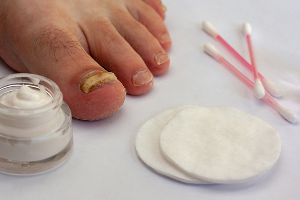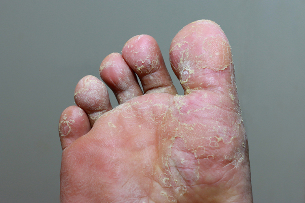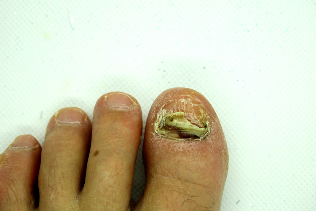Fungus on the toes – a problem of concern to many. Itching, burning and unsightly skin and nails is only a small part of it. The disease is dangerous complications that can cure even more difficult. However, to cope with the problem, if to take seriously the treatment of a fungal infection (mycosis).

Why is there fungus on the feet?
Fungi are one of the types of infectious agents that affect the skin. This intricate and extremely tenacious organisms. Therefore, fungal diseases require a serious and comprehensive approach to treatment.
Fungi have their favorite habitats on the skin. First of all, the skin of the toes and nails. The reason is clear, the feet are usually inside shoes, inside of which accumulates a lot of moisture and dirt, and very hot. Therefore, fungi that live on the feet, lots of food and a favorable microclimate for breeding. Some of the species complex of fungi often affect the skin and other types of fungi, e.g., yeast and molds, I prefer the nail plate. It is also possible the simultaneous infection by several species of fungi.
Contribute to the development of fungus on the toes:
- reduced local and systemic immunity;
- poor hygiene of the feet;
- uncomfortable and tight shoes;
- irregular changing of socks or stockings;
- wearing socks or stockings made of synthetic, non-breathable materials;
- regular overcooling or overheating of the feet;
- circulatory disorders in the legs;
- varicose veins;
- chronic cardiovascular disease, diabetes;
- a long course of antibiotics;
- excessive sweating of the feet;
- the lack of vitamins and mineral elements;
- mechanical damage of the skin, blisters, injuries of the feet;
- excess weight, excessive physical load on the legs;
- irregular trimming of toenails.
The most important of these factors – lowered immunity and poor circulation in the legs. Immunosuppression can occur due to various reasons. This is usually a serious chronic disease, primarily infectious. Also, immunity may be reduced due to HIV, use of immunosuppressive drugs, cancer. Not less important is the circulation in the toes due to vascular disease, blood, diabetes, Smoking.
Mycosis of the feet can develop in men and women. In adults they appear more often than in children.
Some fungi species live permanently on the skin and aktiviziruyutsya only under adverse circumstances, for example, fungi of the genus Candida. But other types are transmitted from person to person. The infection can occur at a gym, sauna, shower, if the person does not use personal shoes. Also significant risk of infection, expose themselves to people who wear other people's shoes or socks, or who give to other people to use them. Often, the infection occurs in the use of the same towels, manicure sets, and t.. d. Factors that increase the probability of infection – cuts on the surface of the skin, deformity of nail plates.
The symptoms of fungal infection of the toes
The main symptoms of fungal infections stop the itching and burning. There may also be redness of the skin, small vesicles, increased roughness and flaking of the skin, unpleasant smell. The first symptoms of fungal infection of the skin can be confused with simple irritation.
Symptoms of onychomycosis
The fungus can affect not only the skin but also the nails. The last type of fungal infection is called onychomycosis. The main symptom of onychomycosis is to change the structure and appearance of the nail, its increased fragility. The nail turns yellow, appear on its surface grooves and cracks, nail plate is thickened and deformed. If left untreated, the nail will gradually flake off from the nail bed and crumble.
Looks like fungus on her finger: picture
Do not put a diagnosis themselves based on the photos. Diagnosis is by a qualified dermatologist.
Only he can determine the type of fungus. This may require not only external examination of the feet, but also laboratory analysis of skin scrapings.

However, the presence of symptoms that even remotely resemble the photos – a cause for concern and seeking medical attention.
Treatment of the disease is complex and is carried out at home under the supervision of a physician.
The fungus on my little finger
The fungus can infect the skin of the toe. But the little fingers on the foot vulnerable to infection. Little finger into the tight shoes is often compressed, which appear on the skin scrapes and blood circulation. With the defeat of the nail of the little finger, the disease develops very fast, faster than any other nails. When infected little finger infection very quickly can also affect other toes.
Fungus on little toe treated in the same way as the fungus in other parts of the skin. In onychomycosis of the nail of the little finger, the most efficient solution may be the destruction of its nail plate. This operation will not cause great inconvenience to the patient, as beloved grows in fast. However, while the nail will not grow back (it can take 3-4 months), it is necessary to use antifungal drugs for the prevention of re-infection.
How to treat fungus on toes?
Treatment of fungal infections should be started at the first sign of symptoms. First and foremost, you need to consult a dermatologist for diagnosis. Before starting therapy it is necessary to establish the fact of the presence of mycosis and the view of pathogenic microorganisms. To this end, the doctor will take a skin scraping or cut a piece of the nail (with the defeat of the nail). Tests blood blood sugar. Mycosis foot skin must be differentiated from:
- other infectious diseases of the skin;
- allergic reactions;
- dermatoses caused by diabetes, vascular disease, stress and nervous diseases.
For the treatment of mycosis on the feet most commonly used local remedies (sprays, ointments, creams). Only in severe cases, the doctor may prescribe antifungal pills. The most frequently used tablets fluconazole with Itraconazole, terbinafine.
Treatment is based on the use of antimicrobials. These drugs contain substances that kill fungi (fungicidal) or stop their reproduction.
Also apply topical preparations antibacterial, anti-inflammatory and keratolytic properties. Antibacterial agents are appointed in the case if suppuration occurs, the fungal infection associated bacterial. Anti-inflammatory drugs to cope well with unpleasant symptoms like itching and burning. However, they do not affect the very cause of the disease – pathogens. Keratolytic by means of zinc, sulfur and like cheese in butter-salicylic ointment. They accelerate the regeneration of skin tissue by accelerating the exfoliation of the dead epidermis.
For the treatment of athlete's foot are also used baths with antiseptic – solution of potassium permanganate, iodine, salt, baking soda, boric acid. The bath is best done before going to sleep for 20 minutes. To prevent infection by spores need to treat healthy areas of the skin with chlorhexidine, iodine, hydrogen peroxide, potassium permanganate. For the treatment of onychomycosis lacquers are used with antimycotic substances. These varnishes should be applied to the nail plate.
Ointments and creams should be applied on washed and clean skin with the frequency specified in the instructions to the tool. The area of application of the ointment should be slightly bigger than the range of visible lesions. For application on nail plate nail Polish nail need to steam, jagged edges to Polish nail file and the nail surface is degreased with an alcohol solution.
In folk medicine for getting rid of fungal infections on the feet are used decoctions of herbs – chamomile, calendula, sage, St. John's wort, mint, white vinegar, onion and lemon juice.
What if the fungus on the finger does not pass?
Treatment of mycosis is a long and difficult process. Fungal microorganisms are very tenacious, and for a couple of days to get rid of them is impossible. Sometimes required many months of rigorous therapy. This is not to interrupt the treatment for a single day. The treatment of onychomycosis cannot be completed until, until you grow new, healthy nail plate.

It is important to also take into account other factors associated with the development of the disease. Poor cleanliness of the skin and of the optimal temperature, the stop can nullify all therapeutic efforts. This means that you must regularly wash the surface of the skin, to avoid overheating or hypothermia. It is also important to avoid mechanical damage of the skin, excessive load on the foot, cuts and injuries. Excess weight increases the pressure on the foot, so if you suffer from completeness, you should think about how to lose weight.
If the patient wears contaminated with fungus shoes, here will not help any powerful drugs because the place of the dead microorganisms here, will occupy the new. So you need to get rid of all the factors that contribute to re-infection. You cannot walk in someone else's shoes, socks. Socks must be thoroughly washed and changed regularly. Inner surface of the Shoe should be thoroughly sprayed with anti-fungal remedies.
For persistent athlete's need to perform General health. Perhaps it will help to identify the causes of immunity disorders and blood circulation in the legs. Therefore, it may be necessary for a complete examination and to rule out a problem with the heart, blood vessels, organs of the endocrine system.
Finally, it is possible that microorganisms have developed resistance to the used antimicrobial agent. It would then be necessary to change the drug. May be necessary, systemic antimicrobial drugs in tablets. The dosage of drugs needs to choose a specialist dermatologist.
























